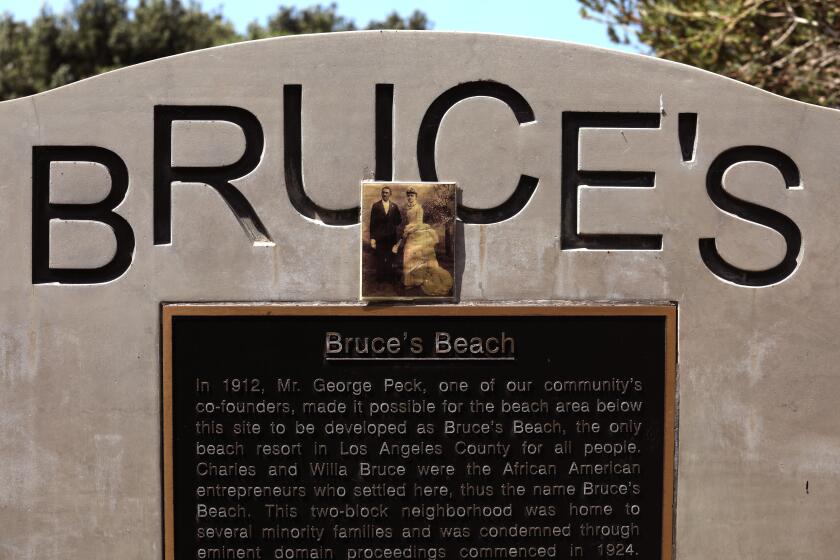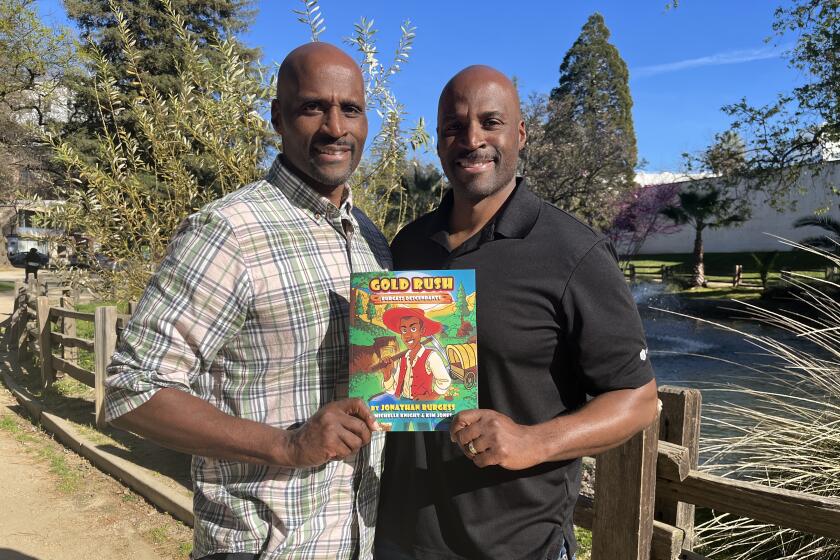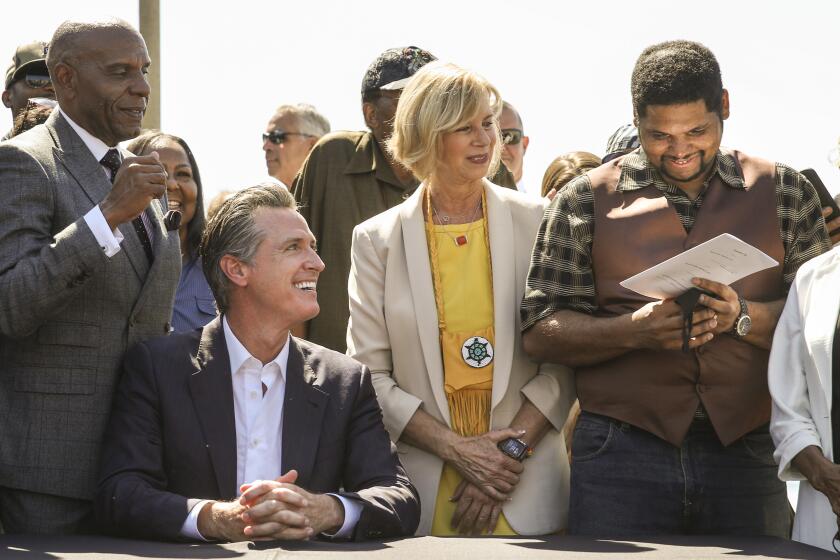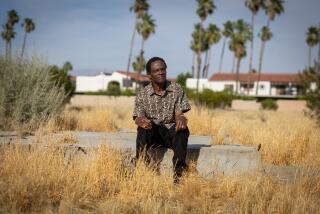Column: Bruce’s Beach was a win for reparations. Why it matters that Black people lost it
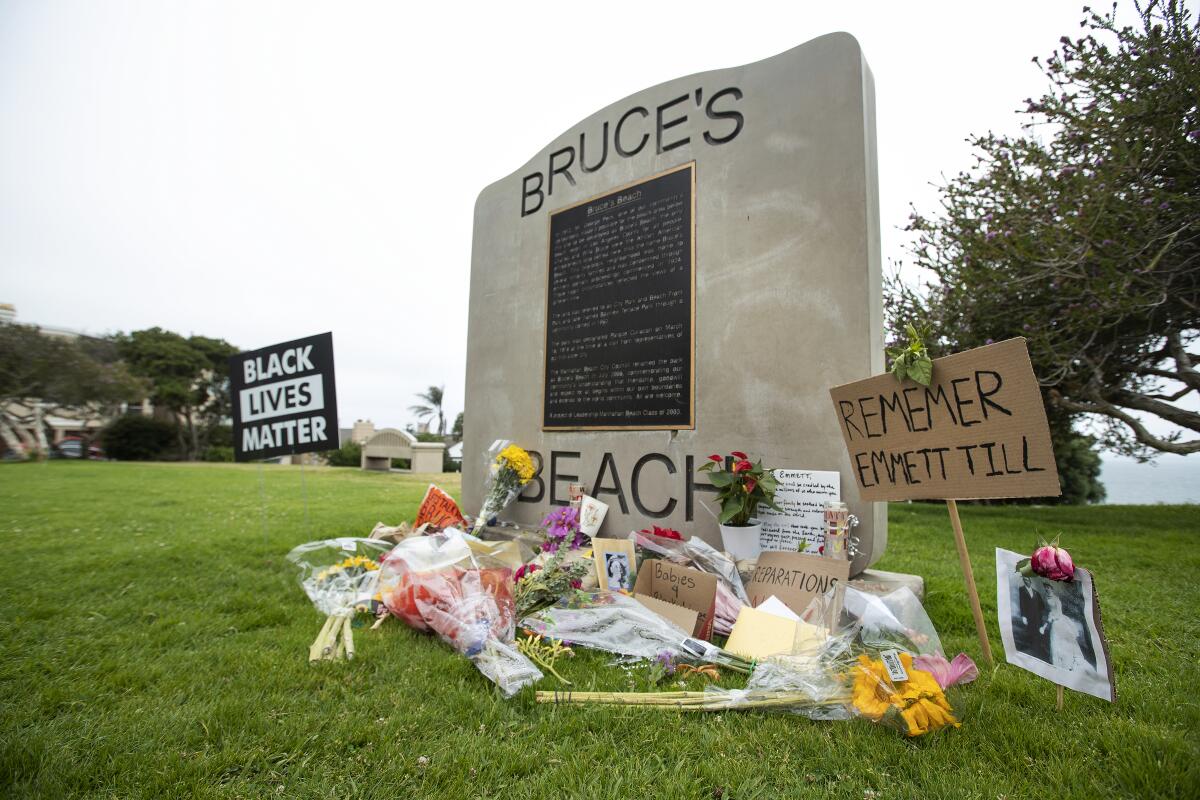
- Share via
Kavon Ward vividly remembers the sunny day in September of 2021 when she won. When Black people won.
Gov. Gavin Newsom had traveled to the overwhelmingly white city of Manhattan Beach to sign legislation that would return two lots of prime real estate to the family of a Black couple who lost it in a racist act of government seizure almost a century ago.
Ward, whose grassroots reparations movement had led to the legislation, put a fist in the air.
“Power to the people!” she shouted. “Power to my people!”
“This can be catalytic,” the governor told the throng of politicians, reporters and curious residents who had gathered on the lots, known as Bruce’s Beach and owned by Los Angeles County. “What we’re doing here today can be done and replicated anywhere.”
Ward didn’t know then what we all know now. That just six months after receiving the deed to the property, the descendants of Willa and Charles Bruce would decide to sell Bruce’s Beach back to Los Angeles County for $20 million.
And that, suddenly, whatever Black people won on that day in September 2021 wouldn’t seem quite as powerful — dealing not only a psychological blow to the burgeoning national movement for reparations to address the many effects of systemic racism, but perhaps a practical one as well.
County officials say the Bruce family has agreed to sell the Bruce’s Beach property in Manhattan Beach back to Los Angeles County for nearly $20 million.
“I am disappointed,” Ward told me after the family announced its decision last week. “We just got it back. It was so hard to get back, and I just worked so hard and the community worked so hard. Black people have lost land — so much land — and this was a win.”
The Bruces, like so many Black families in this country, were unfairly deprived of the chance to build generational wealth.
Willa and Charles Bruce opened a lodge and dance hall for Black beachgoers, after buying two lots along the Strand in 1912. Their operation was so successful that other Black families built homes nearby. Then came threats from the Ku Klux Klan. But when harassment failed to run the couple away, Manhattan Beach seized Bruce’s Beach by eminent domain in 1924.
Today, there’s a lifeguard training facility on the property. But when the deed was officially transferred to the Bruces last summer, the county began paying the family $413,000 a year to lease it — another win that was celebrated.
“All the people that organized and who have marched and protested,” said Ward, who more recently founded Where Is My Land, an organization aimed at helping families like the Bruces nationally, “they’re all upset.”
It’s not that the family’s decision to sell the property is illogical or particularly unreasonable.
Most of their descendants don’t live in Southern California anymore. And Bruce’s Beach isn’t zoned for development, so building another profitable business on the property would take years of negotiations with the state Coastal Commission and Manhattan Beach, the latter of which still won’t even apologize.
“What was stolen from the family was the property, but what the property represented was the ability to create and preserve and grow and pass down generational wealth,” George Fatheree, a real estate attorney who represents the family, told The Times. “And by allowing the family now to have certainty in selling this property to the county, taking the proceeds of that sale and investing it in their own futures, that’s restoring some of what the family lost.”
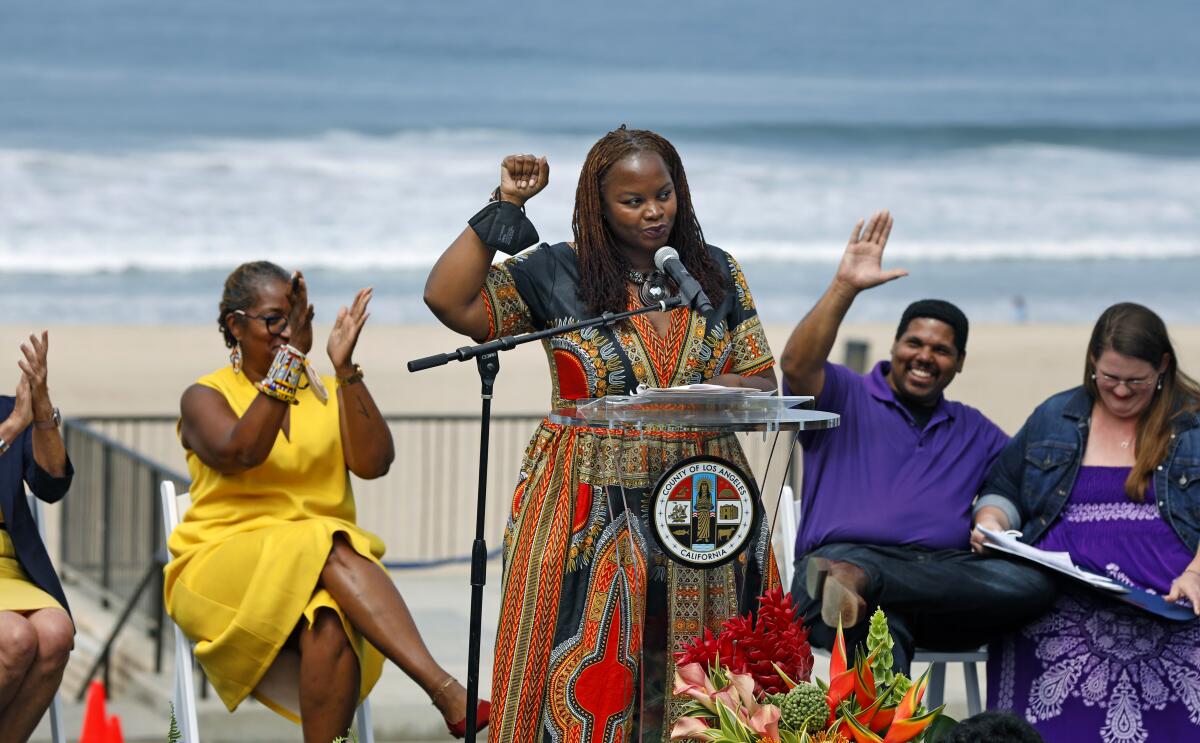
People have a right to do what they want with their property.
But there’s logic and reason, and then there’s emotion and expectation. And because we’re talking about Bruce’s Beach — touted since September of 2021 as the model for reparations — the gap between those extremes has brought up uncomfortable questions that need to be answered. Questions that are bigger than one family or one beachfront property.
Questions like, what are reparations really about? Righting historical wrongs? Making a quick buck? Building a better, fairer future for all Black people? In reality, it’s all of the above, but that doesn’t get talked about enough.
And there are other questions roiling the movement, too. Among them: What exactly are we fighting for? What happens if we can’t reach an agreement on what we’re fighting for? And, perhaps most important, what happens if there is no “we”?
It’s that last question that seems to have particularly irked Ward. Though she had an inkling the family might sell Bruce’s Beach one day, she didn’t think it would be so soon — or happen without any consideration for the grassroots movement that helped get the property back in their hands.
“The people worked together to help them get this land back, but the people weren’t included in the decision,” said Ward, who learned of it after getting off a flight and receiving a barrage of frantic texts. “So a lot of people feel slighted.”
Brothers want California to return land owned by their ancestors. But a task force’s debate over eligibility for reparations is complicating matters.
Julianne Malveaux, dean of ethnic studies at Cal State L.A. and an economist who has long advocated for reparations, had something to say about this, too.
“It was collective consciousness, not just that family, that allowed that [land] transfer,” she said on KBLA Talk 1580 AM last week, adding: “They have a right to satisfy their individual needs and desires, but some of us have a right not to like it.”
In a perfect world, there would be no hard feelings and none of the questions confronting the movement would really matter. But this isn’t a perfect world. It’s a political world.
For reparations to go from being implemented in a handful of cities to being funded across the U.S. will require collective and cohesive messaging to sell politicians and the broader public on the idea. But right now, the movement has a public relations problem.
“One of the things I’ve been trying to get folks to realize is that when we think about reparations, there’s just like this negative connotation almost attached to it where people just automatically assume [it’s about] money,” Ward said.
And unfortunately, the Bruce family deciding to sell their beachfront property for $20 million just months after getting it back is only likely to reinforce that.
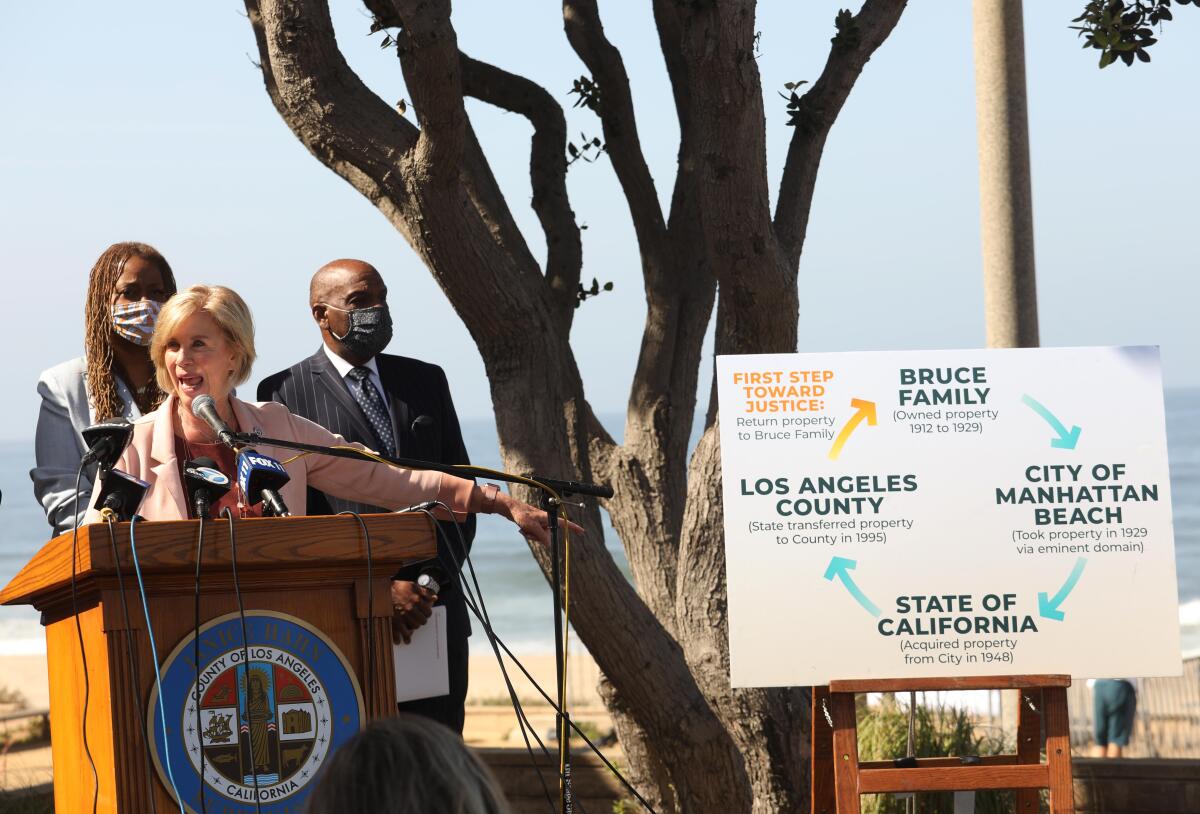
In late November, Pew Research Center released a poll, laying out public opinion for reparations. The findings aren’t promising.
Overall, it found that just 30% of Americans are in favor of providing compensation to the descendants of people who were enslaved in the U.S., with a full 68% of Americans opposed. Unsurprisingly, a majority of Black people — 77% — say descendants should be repaid in some way, while only 18% of white people, 39% of Latinos and 33% of Asian Americans say the same.
The thing that rankled people the most? Cash payments. Of all of the forms that reparations might take, Americans were the least enthused about money being “helpful.” Overall, only 57% of people were in support, compared with 69% of Black people.
What Pew found underscores the drama in December, when right-wing media plucked a dollar figure from a meeting of California’s first-in-the-nation reparations task force and distorted it beyond recognition.
“California is giving every Black person $223,000 as reparations for slavery” was the headline rocketing around social media, moving from ruby red political circles to cobalt blue ones in no time. In reality, the $223,000 is a “preliminary estimate” calculated by economic consultants who were looking at the wealth gap for housing discrimination.
Kamilah Moore, chair of the state task force, addressed the misinformation during last month’s meeting, calling it a “fabrication that the task force has made any recommendations, let alone final recommendations, that have monetary figures.” That hasn’t stopped the flurry of stories quoting Moore making money-centric statements, though.
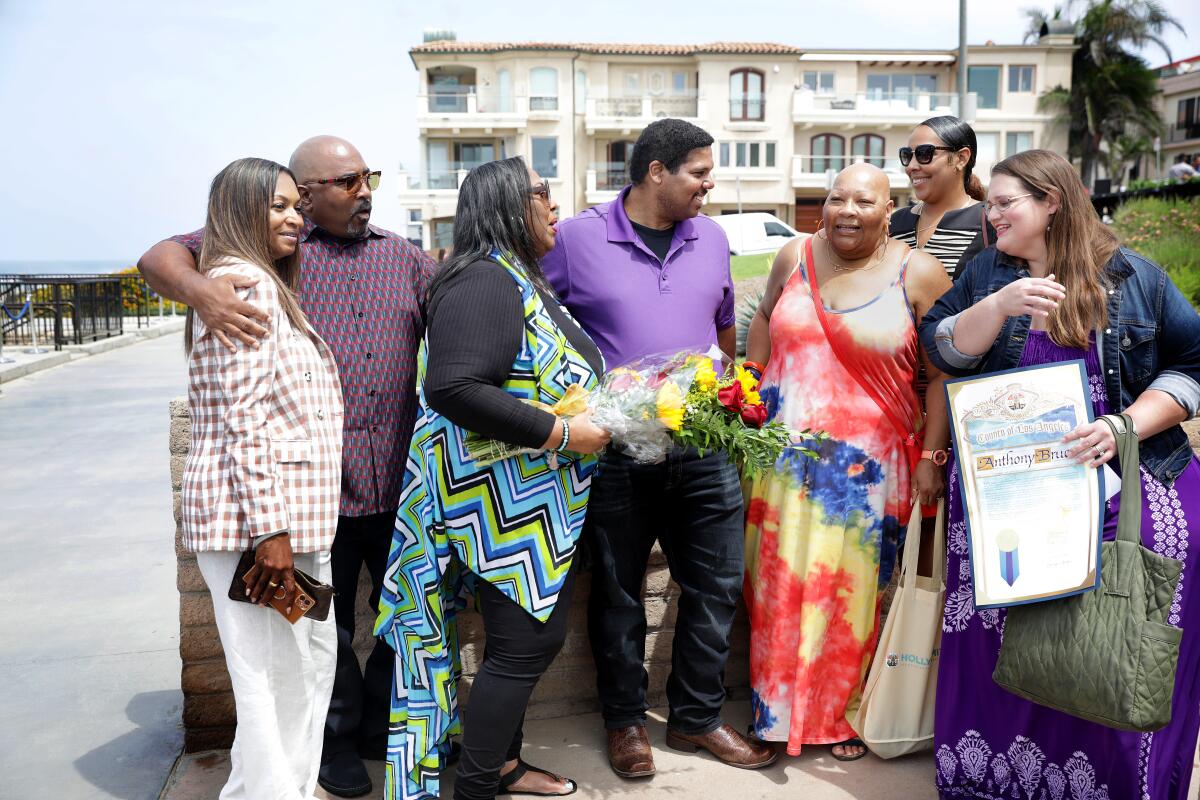
What has been telling is the outrage from the public and politicians, particularly among white people. And it complicates the narrative that the task force must combat as its members wind down their official work this year.
Already, the members have identified categories of harm — governmental property seizure; devaluation of Black-owned businesses; housing discrimination and homelessness; mass incarceration and overpolicing; and health.
Next, the task force must settle on a time frame to calculate damages for each harm and, from there, decide on how many descendants might qualify and what form reparations might take to adequately compensate them. Some of this is likely to be discussed when the members meet in San Diego later this month.
Where the federal government has failed, California enacted new laws that will finally address police misconduct and set an example for reparations.
No doubt cash payments will be on the list of recommendations for the Legislature to adopt. But so will many other things, from college scholarships to financial aid for businesses or tax breaks for buying or remodeling a home — all forms of reparations that a majority of Americans said they supported in the Pew poll.
Thankfully, there has been more of a push from the task force to get that information out to the public in recent months. That must continue.
“I don’t think there’s anything wrong with money being a part of reparations. But it can’t be all of reparations. It’s bigger than that,” Ward said. “Repair is going to take so much more than dollars.”
Perhaps this is the best way to look at the sale of Bruce’s Beach. While $20 million isn’t enough to make up for the harm inflicted on the Bruce family, it is a first step toward repair.
“The fact that land was returned is more powerful than what they decided to do with the land,” Ward added. “So while folks are disappointed at the decision that family got to make, people are also happy that they had the choice.”
More to Read
Sign up for Essential California
The most important California stories and recommendations in your inbox every morning.
You may occasionally receive promotional content from the Los Angeles Times.
